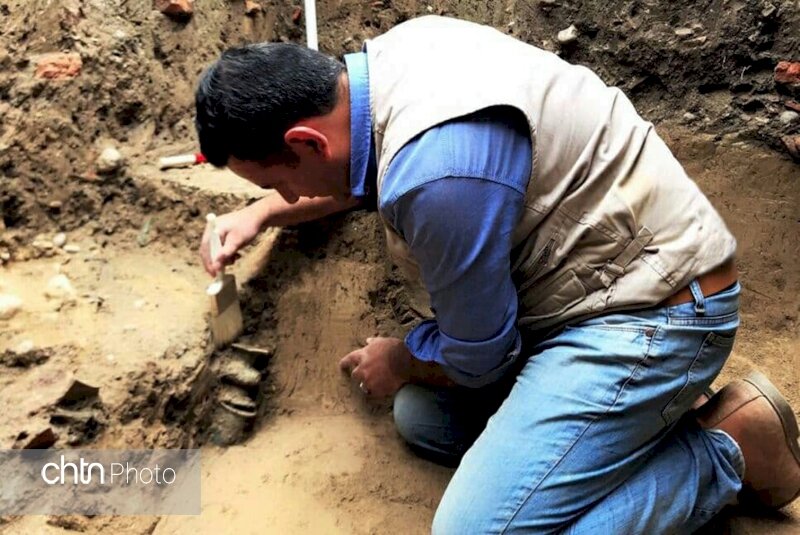‘Unique’ relics unearthed in northern Iran: archaeologist

TEHRAN – A “unique” haul of ancient relics and vestiges of urban structures have been unearthed in Astarabad (or Esterabad) in northern Iran, senior Iranian archaeologist Habib Rezai has said.
“As a result of the excavations carried out in this [archaeological] season, historical artifacts and evidence from the Qajar, Safavid, Timurid, Ilkhanid, and Seljuk eras were discovered. These include architectural remains, pieces of pottery and glassware, as well as metal objects and vessels,” Rezai told CHTN in an interview on Thursday.
A collection of Seljuk-era metal objects (made of copper and bronze), which date back to nearly one thousand years ago, is the most important cultural finding at this excavation, the archaeologist said.
“The metal objects include candlesticks, firecrackers, burners, chandeliers, large and small vessels and utensils, some of which baring decorations and inscriptions.”
“The discovery of such metal collections from the Seljuk era is unprecedented and unique in Iran,” Rezai, who led the archaeological excavation at the site, said.
Astarabad is the older Islamic name for the modern town of Gorgan in Golestan province. It lies at the southeastern corner of the Caspian Sea, and is essentially a lowland and piedmont area, rather drier in climate and habitat than the semi-tropical regions of Mazandaran and Gilan further west; it forms a transition area, both from the climatic and the vegetational aspects.
“Architectural evidence and a collection of available sources and [historical] travelogues show that [the modern] Gorgan lies on the historical city of Astarabad, and certainly in the lower layers of this historical city, valuable cultural artifacts can be retrieved,” the archaeologist explained.
Talking about future excavations at the site, the expert noted: “To complete the archaeological knowledge of this treasured site, the excavations should be continuing at this site to reach the virgin soil.”
“Future excavations and additional studies can give answers to many of our questions about the spatial function of the site of the discovery of this unique metal treasure… and also the study lower cultural layers and deposits related to the Seljuk period will help to do so.”
Asterabad is situated along a small tributary of the Qareh River, 37 km from the Caspian Sea. The ancient city, in existence since Achaemenian times, long suffered from inroads of the Turkmen tribes who occupied the plain north of the Qareh River and were subjected to incessant Qajar-Turkmen tribal conflicts in the 19th century.
It was renamed Gorgan in the 1930s after being devastated by an earthquake. Articles of trade include cereals, soap, and carpets. In modern times the plain around Gorgan has become a flourishing granary.
Furthermore, Gorgan is home to an immense defensive wall of the same name (“The Great Wall of Gorgan”) which is stretched some 200 km in length, built to prevent the invasion of the northern tribes. It is said to be the longest architectural work of ancient Iran, which was built in 90 years.
Also known as Red Wall, which in some ancient texts is referred to as the Red Snake, this wall is the longest brick ancient barrier between Central Europe and China, longer than Hadrian’s Wall and the Antonine Wall put together and the third-largest wall in the world after the walls of China and Germany.
Most parts of the gigantic monument are still hidden underneath the surface through some segments that have so far been unearthed and even restored to former glory.
Golestan is reportedly embracing some 2,500 historical and natural sites, with UNESCO-registered Gonbad-e Qabus – a one-millennium-old brick tower – amongst its most famous.
Narratives say the tower has influenced various subsequent designers of tomb towers and other cylindrical commemorative structures both in the region and beyond. The UNESCO comments that the tower bears testimony to the cultural exchange between Central Asian nomads and the ancient civilization of Iran.
Seljuk, also spelled, Seljuq, was a ruling military family of the Oguz (Ghuzz) Turkic tribes that invaded southwestern Asia in the 11th century and eventually founded an empire that included Mesopotamia, Syria, Palestine, and most of Iran. Their advance marked the beginning of Turkish power in the Middle East.
AFM/

Leave a Comment